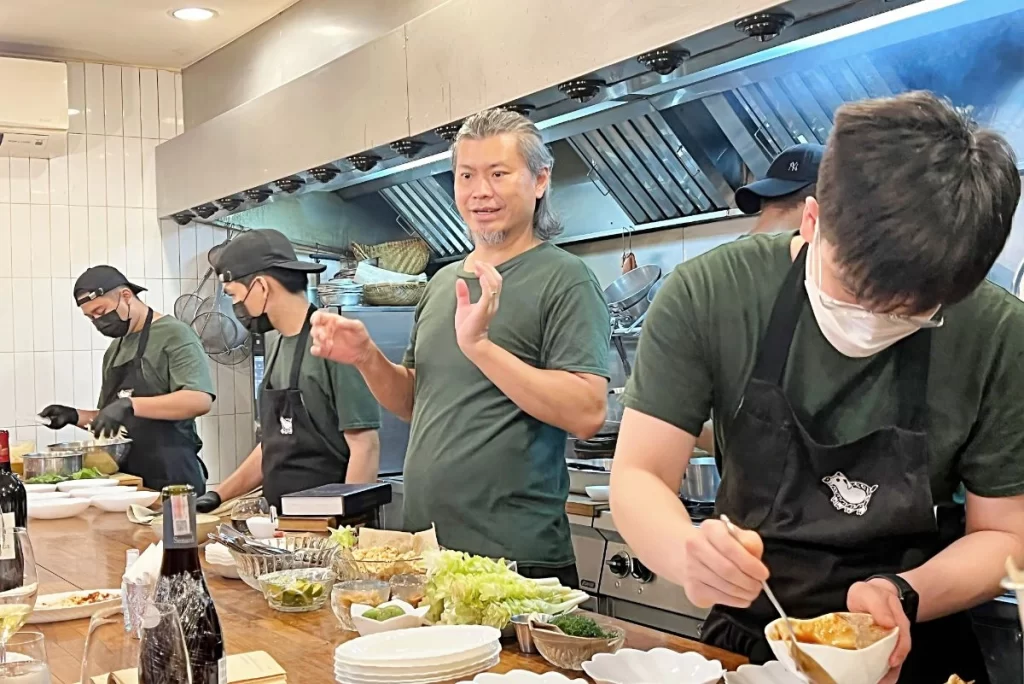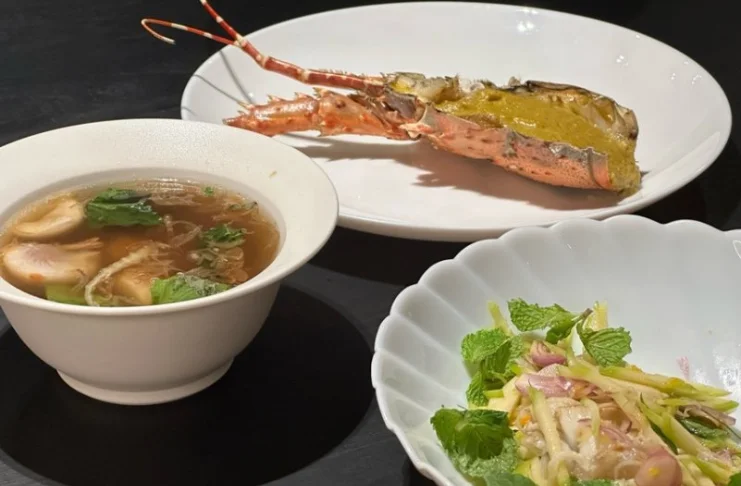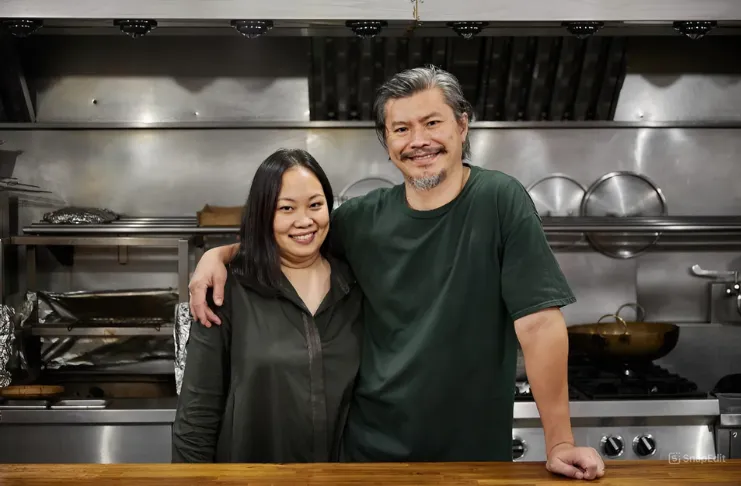In a city obsessed with the next big thing, Samrub Samrub Thai is looking the other way.
On any given night at this restaurant, you might be served a curry no one has cooked in 70 years or a dish pulled from the pages of a cookbook printed before World War II. No reinvention, no fusion, just the kind of food Thailand almost forgot it had.
At the center of this idea is Chef Prin Polsuk, who treats cooking as an art of preservation.
A Scholar in the Kitchen
It all started when Chef Prin Polsuk could no longer shake the feeling that Thai food (real Thai food) was slipping through the cracks.
He grew up around the kind of cooking that never made it onto restaurant menus: dishes passed down through generations, measured by instinct rather than recipe. Later, under the mentorship of David Thompson at Nahm in London and Bangkok, he learned the discipline of professional kitchens. Still, it was the depth and detail of old Thai cookbooks that really pulled him in. He started collecting them, some even dating back to the early 1900s, and reading them the way others might read poetry or philosophy.
“I’m not trying to invent anything,” he says. “I’m just trying to understand what we’ve already done, properly.”
At Samrub Samrub Thai, he meticulously decodes century-old techniques, sources lost ingredients, and revives recipes that haven’t been cooked in decades. It’s slow, precise, and the kind of work that doesn’t scale.
That’s why the restaurant is small—just 12 seats—and the menu changes constantly, depending on what the market offers that morning.
“The ingredients tell me what to cook,” Chef Prin says. “Not the other way around.”
Every dish is prepared from scratch, in full view of the guests, using traditional tools and methods: clay pots over charcoal, herbs hand-pounded in stone mortars, and vegetables cut with knife work that borders on surgical.
A Culinary Classroom

Thanyaporn “Mint” Jarukittikun, Chef Prin’s partner in life and business, brings a background in cultural preservation to the restaurant. She manages the front of the house and shares the mission of education through gastronomy.
“Each dish tells a story about Thai culinary thinking,” Mint explains. “The way flavors are balanced, the sequence of dishes, even how they’re eaten, these are cultural practices, not just food.”
Beyond serving exceptional meals, Samrub Thai functions as a platform for education. Chef Prin and Mint are committed to passing on their knowledge to the next generation of chefs and food enthusiasts. They collaborate with local communities, support sustainable farming practices, and are in the process of compiling their recipes into a go-to book.
“We want to give back,” Mint explains. “We work with communities and local farmers more than when I was working at the UN, so we’re making it happen through the knowledge and experience we have gained.”
Despite international recognition, the restaurant maintains a distinctly local sensibility. Prices remain reasonable by fine dining standards. Reservations, however, remain notoriously difficult to secure, often requiring booking months in advance.
“We keep the restaurant small because this food requires attention,” Mint explains. “Each dish needs to be made fresh, with no shortcuts. We could serve more people, but then we wouldn’t be cooking with the same care.”
The Politics of Preservation
In a world where food trends often veer toward theatricality and spectacle, Samrub Samrub Thai is quietly subversive. It challenges the assumption that fine dining must involve deconstruction or visual drama. For Prin and Mint, serving a dish exactly as it was meant to be served is a political act.
“We are not nostalgic,” Prin clarifies. “We are serious. There’s a difference.”
He often questions the misconception that their cuisine is backward-looking or sentimental. It isn’t. It’s historical, yes. But it’s also an effort to correct the record, to offer a counterpoint to the dominant narrative that often compresses Thai food into a handful of oversimplified dishes.
Mint adds, “The recipes we cook existed before Thailand was even Thailand. They belong to different kingdoms, different moments.”
Indeed, some of the recipes they revive originate from royal courts, while others are from rural households. Each one tells a story about migration, trade, colonization, and resilience. As a result, dining here can feel like stepping into a portal, not to a singular Thailand, but to many Thailands layered across time.
The Anatomy of a Menu
The menu at Samrub Samrub Thai is not built around ingredients in season or global trends. It is designed like a narrative: a series of chapters told course by course.
One dinner might begin with a fermented fish relish from Isaan, followed by a smoky southern curry known for its punishing heat, and end with a dessert inspired by a royal banquet held during the reign of King Rama V.
“We want to bring guests through regions and timelines,” says Mint.
That’s why no two meals are ever the same. Guests don’t come expecting their favorite dishes. They come to surrender to what the chefs have discovered, researched, and perfected for that day, that week. And those dishes may never appear again.
Even the dining sequence matters. Prin pays close attention to how flavors build and decline over the course of a meal, aligning each transition with traditional Thai culinary logic, which is different from Western fine dining norms.
“In Thai cuisine, there’s no starter or main,” he says. “It’s more about contrast and harmony across dishes, not hierarchy.”
That philosophy informs how each menu is built: a choreography of textures, spices, and regional signatures that tell a fuller, more truthful story of Thai identity.
It’s the opposite of convenience dining. It asks for your attention. Your time. Your curiosity.
And that, in today’s fast-paced dining culture, is perhaps the boldest move of all.
The Taste of History

Signature dishes at Samrub Samrub Thai include the Chantaburi Jungle Curry of Beef, a complex preparation featuring a medley of herbs and spices like green Thai bird’s eye chilies, hot basil flower, and wild ginger. Another standout is the deep-fried great white sheatfish stuffed with shrimp paste and turmeric, inspired by southern Thai cuisine.
These dishes are crafted with attention to detail, from the slow toasting of fermented shrimp paste in the Nam Prik Kapi Khua to the precise balance of flavors in every component. The result is a dining experience that delights the palate and offers a window into Thailand’s culinary history.
A Living Legacy
As you finish your meal, perhaps with a traditional Thai dessert like Khanom Mo Kaeng (a custard made with duck eggs and palm sugar) or Thong Yip (egg yolk sweets that originated in Portuguese-influenced Thai royal cuisine), you realize what makes this place so special.
For anyone who truly wants to understand Thailand, not through tourism brochures or fusion dishes but through the ingredients, techniques, and philosophies that shaped its past, this is the table you need to sit at.
Come with questions. Leave with reverence.
Because at Samrub Samrub Thai, the food doesn’t just speak. It remembers.





